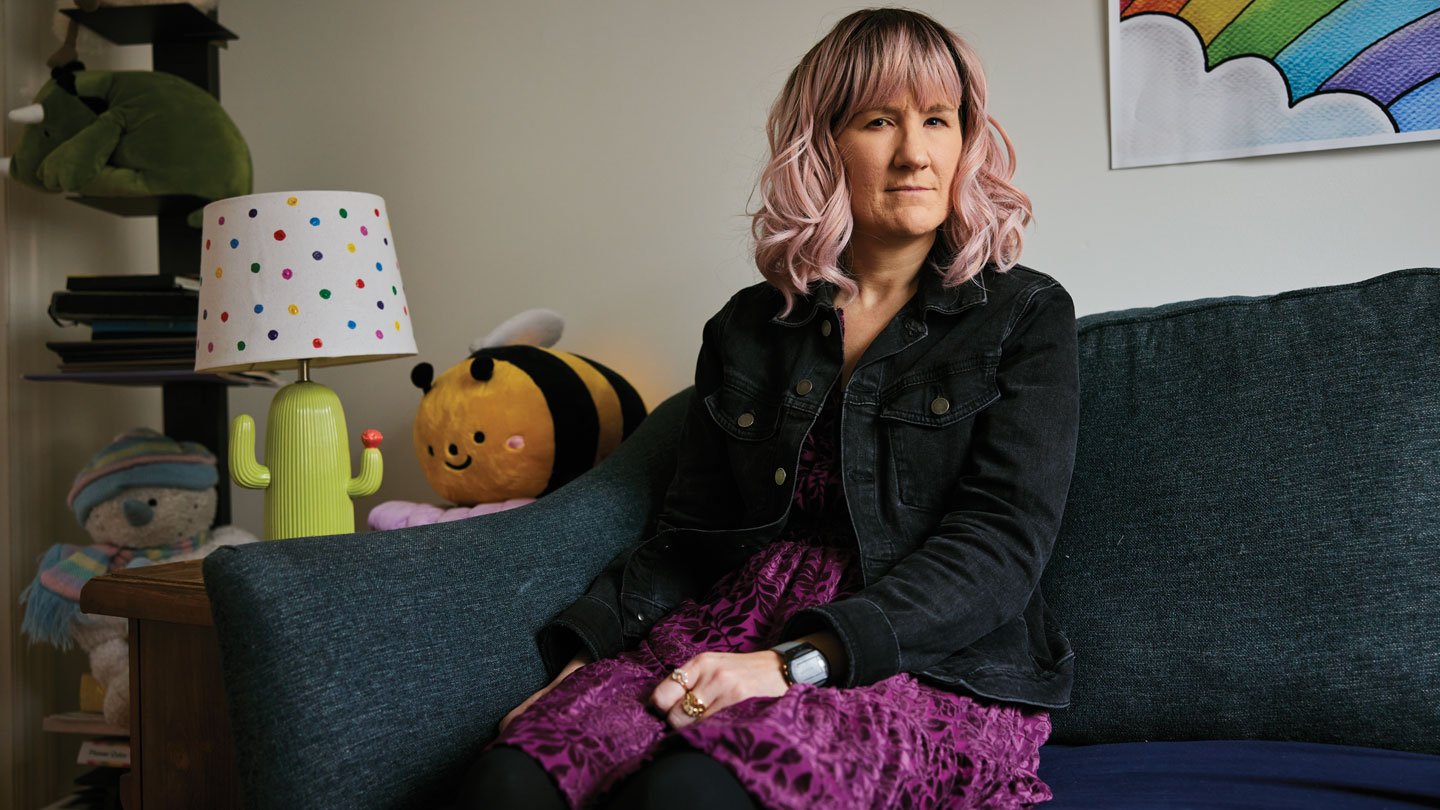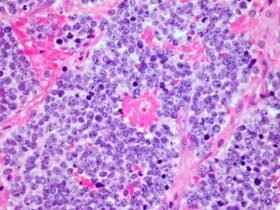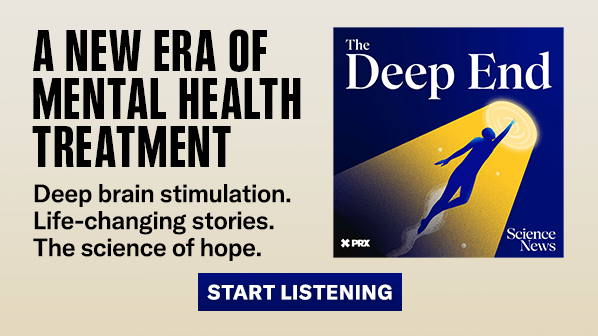This is episode 2 of The Deep End. Listen to more episodes here.
Depression can affect not just the mind, but the body, too. Inner experiences of mental struggles are private. But in this episode, Jon Nelson and another volunteer, Amanda, let listeners in. Woven into their stories is a brief history of deep brain stimulation, the experimental treatment that involves permanent brain implants. You’ll hear how that research — with its ups and downs — carried the experiments to where they are today.
Transcript
Laura Sanders: This episode deals with mental illness, depression, and suicide. Please listen with care. Previously on The Deep End:
Barbara: He would be up in bed with the lights out or watching like endless hours of television and it was very unpredictable and then there’s a whole life going on downstairs.
Jon: That isolation, there’s a little bit of lying involved because you just wanna get out of things, right?
Mayberg: I think part of why this kind of treatment resistant depression is so painful and so associated with high rates of suicide, is that you’re suffering. You know exactly what you’re trying to get away from and you can’t move. And if you do move, it follows you. There’s no relief.
Jon: I’d be the one standing up in front of everybody leading the champagne toast, and then I’d be driving home and wanting to slam my car into a tree.
Sanders: Today we’re going to get into some heavy stuff, but there’s light at the end, I promise. We’re going to pull back the curtain on what depression can do to the body and to the brain. Maybe you know that feeling firsthand. If you don’t, you probably know somebody who does. You’ll also hear the backstory of some people who volunteered for the experiment and the backstory of the science itself. I’m Laura Sanders. Welcome to The Deep End.
Jon: I had poison in every single bit of my body. It literally ran throughout every cell in my body. My blood carried the poison, and it crushed everything in me.
Sanders: Jon Nelson’s depression wasn’t just in his head. It was in his whole body.
Jon: The way that I put it in the kind of let people understand it who don’t have depression is every single person’s had the chills and aches when they have a fever, right? You feel it physically in your body. I felt that all the time, but it felt like death. It felt like dread. It felt like a massive blanket of hell literally on my body and inside of me at all times. And it never left.
Sanders: When Jon told me this, it reminded me of a very old idea. It goes all the way back to ancient times, back when the word melancholia meant depression. That name comes from the ancient Greek word for black bile. Back then, people thought this was a diseased liquid that corrupted the body. The treatment, bloodletting and leeches. Today’s doctors don’t bleed people with depression. There are much more effective and humane treatments.
But there are still some people who aren’t helped by them. Jon is one of those people, and so is a woman named Amanda. She describes her depression as a vortex, a vortex that was inside of her and destroyed everything good. She’s lived with these feelings for a long time.
Sponsor Message
Amanda: I was 13, I think. At the time, I didn’t realize I was depressed, cause I didn’t realize, I didn’t know depression was a thing. But when I look back on it, and I, I can like remember my little self sitting on my bed in the middle of the night wishing I was dead. Like, yeah, I’m pretty sure I was depressed.
Sanders: Since then it’s been a long hard road for Amanda. Like Jon, she can rattle off a long list of therapies she’s tried in her search for relief. She’s tried transcranial magnetic stimulation, or TMS. That’s when strong magnetic fields are sent into the brain to change its behavior. Amanda also tried ketamine. That’s the anesthetic that Matthew Perry had in his body when he died.
Amanda: So my journey was, I tried 21 different antidepressants over the course of 10 years. I did TMS. I did IV infusions of ketamine. And then I did 40 rounds of electroconvulsive therapy. The only things that kind of helped a little, the ketamine helped a little bit for a little while, but then my body adjusted to it and it stopped working completely.
Sanders: Electroconvulsive therapy, also known as ECT, is the gold standard treatment for people who aren’t helped by other methods. ECT has a tough history. It was formerly known as electroshock therapy. Most people think of this technique in pretty negative ways. It was the basis of the horror in the movie One Flew Over the Cuckoo’s Nest. But ECT has come a long way since then. For unknown reasons, the resulting mini seizures in the brain can provide relief. That’s why Amanda’s doctors had her try it. ECT is often done several times a week for 3 or 4 weeks. Did you catch it when Amanda said she had 40 rounds?
Amanda: The electroconvulsive therapy helped a little bit, but for it to help, I had to do it so frequently that I got memory damage, and I was like, “Whoa, whoa, whoa.” I was like, “I don’t remember where my sock drawer is. I don’t remember what subway stations are near my apartment.” I forgot how to use the software I’ve been using every day for 10 years. Like, I gotta stop.
So, I sort of, after I gave up on ECT, I, I sort of like spiraled downhill pretty hard. I ended up trying to kill myself. And so then I was, well, I was unsuccessful, so they took me to the hospital. And I was hospitalized for 6 weeks and then in an outpatient program for 6 weeks. But it was at that point where they were like really like, “You really tried everything. Like, there’s nothing else we can do for you. There’s like literally nothing else out there. You’ve tried every class of antidepressant there is. There’s no, like, if ECT doesn’t work, that’s it, kind of.” And so I was just with doctors that had given up on me.
Sanders: If this sounds similar to Jon’s story, that’s because it is. Their journeys differ in the specifics, but they both know what it’s like to live without hope.
I first interviewed Amanda over Zoom. But when I visited her apartment in New York City, I was struck by something that I was not expecting. Her entire apartment was brimming with rainbows and sunshine. Amanda is an artist.
Amanda: I would describe my work, I think, as like sort of an exploration of a couple things. Like, I’m really interested in color. Like, that’s my favorite thing ever. I love color. And also shape. Like, I’m really interested in, like, what are the, what are the shapes that I find pleasing for things? And then I also, I’m sort of interested in a little bit of mixed media, like, I like taking photos and drawing cartoons into the photos. My favorite shape is a circle. I love circles.
Sanders: Her whole life, Amanda has drawn. One of the recurring characters in Amanda’s art is named Cartoon Amanda.
Amanda: And she is mostly like me. She, she acts like me. She responds to situations the way that I would. She’s, she’s excited about things that I’m excited about. She’s a little more bold than I am, because she is like, I like, I really love rainbows, but for the most part I don’t dress like a rainbow all the time. But Cartoon Amanda is dedicated to rainbows. Like, she dresses like a rainbow. She’s into it like. So she’s like, she sort of lives my dream a bit.
Sanders: When Amanda, real life Amanda, was in the depths of depression, she didn’t want to think about sad things or hard things.
Amanda: Like I use bright colors to cheer myself up. I don’t generally, when I was really depressed, I didn’t like to draw really depressing things. I wanted to like sort of pull myself through or pull myself along with things that were more uplifting, and I definitely used color to do that.
Sanders: But she got to a point where she was in misery and no rainbow palette could help. Desperate for help, Amanda called the treatment resistant depression program at Mount Sinai. After describing all of her unsuccessful treatments, Amanda was once again passed along to different doctors. That last handoff is what delivered Amanda to the DBS research program.
Amanda: The year before, I had attempted suicide, and I felt like that was going to happen again if something didn’t, if something didn’t work. And so I was like, this may be crazy. This may, this may not work out. I might die, but like if I don’t, if it doesn’t, I still might die. Like, it still might, I can’t go on like this. And so it was kind of like, “Well, if it’s the only option, then, then so be it.”
Sanders: As doctors explained the procedure, their research, and the risks, Amanda listened carefully.
Amanda: And then they gave me this, like, 44-page packet of disclaimers and, like, it was every terrible thing that can happen to you. You can get an infection, you can get clots, you can, it like goes through the whole thing, and I was like, well that makes it worse, but whatever it takes.
Sanders: Whatever it takes. So you, did you, did you read it?
Amanda: I read the whole thing.
Sanders: And you were not dissuaded one bit, you thought, “This is, this is a shot I should take.”
Amanda: Yeah, I mean, it seemed like a more difficult endeavor after that, after reading that, but it, it definitely, I was not deterred.
Sanders: Amanda arrived at appointments prepared with an eight-page long list of questions that she emailed me later. The questions covered the practical, like, “What should I avoid forever? Running, hanging my head upside down, trampolines?” And the questions covered the profound. “What makes a person want to be alive?”
The deep brain stimulation program that prompted all of Amanda’s questions looks vastly different from earlier versions. To understand DBS research, we have to go back to the beginning. We’re going back decades, when researchers were just starting to figure out what’s different in the brains of people with depression. Here is neurologist Helen Mayberg, one of the leading researchers in deep brain stimulation.
Mayberg: I mean, depression is overwhelming. It’s all consuming. Just talk to a patient. But in fact, it doesn’t affect all areas of your brain. But it certainly affects some pretty critical centers. And early on, it was a very simple-minded question to map depression. But when you put someone in a PET scanner and you looked at the activity, the metabolism of the brain, there was a clear pattern that was very different from people who weren’t depressed.
Sanders: The brains of people with depression behaved differently, and those differences led Mayberg to wonder whether electricity could help. For deep brain stimulation, electrodes are permanently implanted in the brain and deliver small pulses of electricity. Those pulses can change the brain’s behavior. DBS has been around a long time, actually. It was approved by the US Food and Drug Administration in 1997 to treat tremors. These are involuntary muscle movements. The treatment was approved in 2002 to treat Parkinson’s disease. Why not depression?
Mayberg: It was, in some ways, pretty straightforward to say, do you think you can put the electrode here instead of in this other place you use for Parkinson’s. So if you can implant safely, the principle was the same.
Sanders: In 2003, Mayberg and her colleagues were ready to try. This first step wasn’t to see if her idea actually worked, it was to see if it was safe. You heard about Mayberg’s first volunteer in the previous episode. Here’s the full story.
Mayberg: So when we were ready to do this, actually this was, the first patient was a psychiatric nurse. And her attitude was, “Whatever. It’s unlikely to work, but why not try, because maybe I can help you learn something.”
Sanders: The surgery went as planned. Mayberg wasn’t the surgeon. Her role there was to observe any change that resulted from the stimulation during the operation. She wanted the patient to feel calm and stay observant.
Mayberg: And I’m not a particularly good poker player myself, so I remember being nervous because again, not my hands in her brain. I, all I can do is watch, and observe, and react. So the instructions were, look, we are going to turn it on, and we’re going to turn it up slowly, and your job is to tell us if you notice anything.
Sanders: They began running through all the different electrodes, stimulating one at a time.
Mayberg: And so we started at the bottom contact. There’s an electrode in each side of the brain. We started on the left side, we started at the lowest one. We turned it on at low current. We turned it up, you know, relatively quickly, you know, increased the dose to kind of the, not the maximum, but kind of higher, twice the dose that you would ever use in Parkinson’s, waiting to see if she noticed anything. And she didn’t notice anything. So then we moved to the second contact and tried it again, and she didn’t notice anything.
Look, depression, when you get better on a medicine, it takes a while, you know. It’s not a rapid-acting effect. That, we really were doing a safety experiment in the OR to make sure that, I wasn’t expecting anything to happen, so turning it on and turning it up and having nothing happen was just exactly what I wanted.
Sanders: No response was a good response as far as Mayberg was concerned, but that’s not what happened.
Mayberg: And so it was pretty surprising when we get to the third contact and we start to turn it up and we get to about five volts. It’s like it goes from zero to 10. And all of a sudden, patient goes, “Oh, that’s interesting. The void is gone.”
Sanders: That got the researcher’s attention.
Mayberg: We went with it. What’s a void? What’s it feel like? What are you talking about? Explain it. And she goes, and then it was actually, she got a little testy, because somehow I was supposed to know what that was, which was kind of funny.
I don’t know how to describe it. She goes, “You’re, there’s a lightness. It’s, it’s a clearing.” And you can see her struggling for a word, to the point of being sort of annoyed. And she kind of, she kind of, well, you can’t, like, flip your head around because she’s like bolted into the machine. But she kind of lifts her hand and like she’s kind of flipping you away, and she kind of goes, “Look, it’s like you’re trying to ask me the difference between a laugh and a smile.”
Sanders: Those early results from this patient and others were promising. So in 2008, Mayberg and her collaborators began enrolling people for a large DBS clinical trial. Called the Broaden trial, the six-month study followed 90 people with severe depression. All 90 got brain implants, but the scientists wanted to know if the electricity flowing through those implants helped. So some people had electrical stimulation on, and some had the stimulation off. Neither the patients nor the scientists knew which people were getting stimulation. This is what’s called a double-blind trial. Researchers kept track of how everyone felt over the months that followed.
The results were not good. In fact, they were so bad that the experiment was stopped early.
By six months, the people with their stimulation on were no better off than those who didn’t have it on. The sponsor and maker of the DBS device, Saint Jude Medical, determined that the trial wasn’t likely to hit its goals. Around the same time, there was another unsuccessful trial.
This one had 30 people who received stimulation in a different part of the brain. These disappointing results were a real setback. Those failures led to criticism of DBS as a treatment for depression. Some critics thought the research was being driven by financial interests. Mayberg, for instance, receives fees for consulting and licensing intellectual property from Abbott Laboratories. That’s the company that bought Saint Jude Medical. These sorts of financial relationships aren’t necessarily problematic, but they do exist. Despite setbacks and despite criticism, the research didn’t stop. It matured. Advances began to slowly accumulate.
Mayberg: There’s been a lot of progress. It’s not helpful when people say a company failed, ergo, it doesn’t work. When the reality is, that is not true. It just didn’t scale properly. That means you need to understand what went wrong and make adjustments. But it’s gotta scale.
Sanders: Scientists kept going, focusing on imaging and longer-term follow up. They got better at understanding their method and better at grappling with the variance, with the uncertainty and the mysteries. Those changes brought the treatment to where it is today, with small studies happening and the science still improving.
Mayberg: We can’t make science go any faster than it goes, but we can be aware of the need to go as fast as possible.
Sanders: This history, full of promising ups and crushing downs, ultimately delivered the experiment that Amanda, Jon, and others encountered in 2022.
Amanda: So the day of the surgery, I remember not being very nervous. We first, when we first walked into the OR, that was the first time I got scared. That was the first and only time I got scared. It just, I saw the machine there that, that, they have this thing that’s sort of like a CAT scan but it’s like a little bit smaller so they can do surgery around it. And I saw the big operating room, and I was like, “Oh this is real this. This is gonna happen.”
Sanders: In the run-up to his own surgery, Jon was cool as a cucumber. He had already been through so much just to get into that clinical trial. He truly wasn’t worried about it. Well, OK, he told me he was worried about one thing.
Jon: The hardest part for me by far was shaving my head. It was very emotional for me. I’ve been self-conscious my whole life. I got a big head in a good way, but as my, my brother always makes fun of my big head. Now I gotta shave it. And that was the hard part for me. It wasn’t the, the, the surgery, prepping for that, it was like, “Oh my gosh, now I’m gonna look funny, right?”
Sanders: But the 8 hour brain surgery to him, that was nothing.
Jon: Getting prepared for the surgery was no stress for me at all. It was like I was going to get my teeth cleaned.
Sanders: It was a different story for Jon’s wife, Barbara. She remembers wondering, “What if they slip or they sneeze and they ruin his brain?”
Barbara: But I was really, really, really scared, really scared.
Sanders: But more than that, she was worried about the outcome, about what happens next in the days, weeks and months after the surgery, once the electricity starts flowing into Jon’s brain.
Barbara: And if it, what if he dies on the operating room table, what if it doesn’t work? What if it, what if it does work?
Sanders: On the next episode, you’ll find out how Jon’s surgery went. You’ll hear how he felt in the days and weeks after this experimental treatment began, and what it was like to have electrodes pulsing electricity directly into his brain. You’ll hear from Jon’s wife Barbara too.
Barbara: And I would joke to my father like ask him if he feels like doing dishes. Like, that’s the that’s the setting we want. But they were, they they were futzing around with this thing that was gonna change him, you know?
Sanders: If you or someone you know is facing a suicidal crisis or emotional distress, call or text the 988 Suicide and Crisis Lifeline at 988. This is The Deep End. I’m Laura Sanders. If you liked this podcast, tell your friends or leave us a review. It helps the show a lot. Send us your questions and comments at podcasts@sciencenews.org.
The Deep End is a production of Science News. It’s based on original reporting by me, Laura Sanders. This episode was produced by Helen Thompson and mixed by Ella Rowan. Our project manager is Ashley Yeager. Nancy Shute is our editor in chief. Our music is by Blue Dot Sessions. The podcast is made possible in part by the Alfred P. Sloan Foundation, the John S. James L. Knight Foundation, and the Burroughs Wellcome Fund, with support from PRX.
Episode 2 credits
Host, reporter and writer: Laura Sanders
Producer: Helen Thompson
Mixer: Ella Rowen
Sound design: Helen Thompson and Ella Rowen
Project manager: Ashley Yeager
Show art: Neil Webb
Music: Blue Dot Sessions
Sound effects: Epidemic Sound
Additional audio: Luke Groskin, Mayfield Brain & Spine
This podcast was produced with support from PRX, the John S. and James L. Knight Foundation, and the Burroughs Wellcome Fund.
If you have questions, comments, or feedback about this episode, you can email us at podcasts@sciencenews.org.
Source link














Leave a Reply